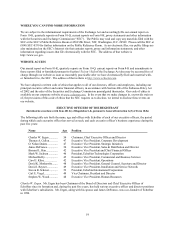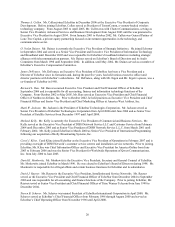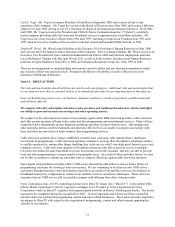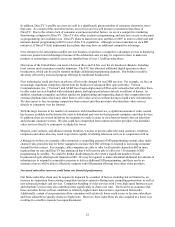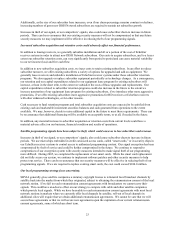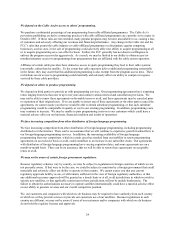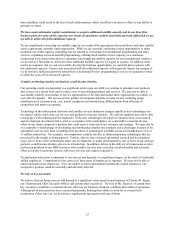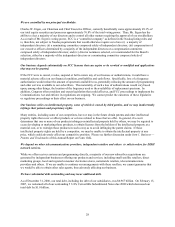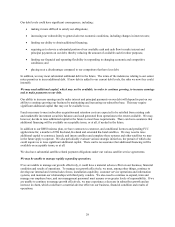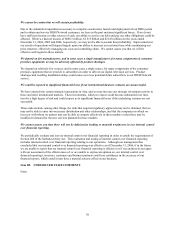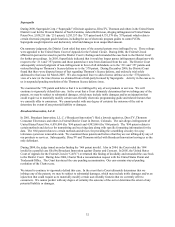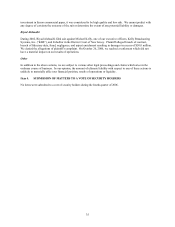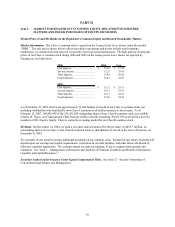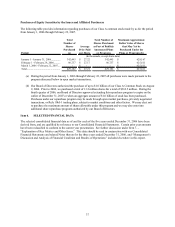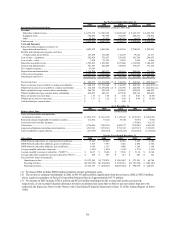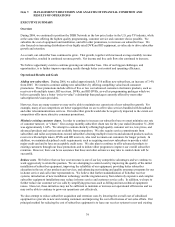Dish Network 2006 Annual Report Download - page 39
Download and view the complete annual report
Please find page 39 of the 2006 Dish Network annual report below. You can navigate through the pages in the report by either clicking on the pages listed below, or by using the keyword search tool below to find specific information within the annual report.29
Our debt levels could have significant consequences, including:
• making it more difficult to satisfy our obligations;
• increasing our vulnerability to general adverse economic conditions, including changes in interest rates;
• limiting our ability to obtain additional financing;
• requiring us to devote a substantial portion of our available cash and cash flow to make interest and
principal payments on our debt, thereby reducing the amount of available cash for other purposes;
• limiting our financial and operating flexibility in responding to changing economic and competitive
conditions; and
• placing us at a disadvantage compared to our competitors that have less debt.
In addition, we may incur substantial additional debt in the future. The terms of the indentures relating to our senior
notes permit us to incur additional debt. If new debt is added to our current debt levels, the risks we now face could
intensify.
We may need additional capital, which may not be available, in order to continue growing, to increase earnings
and to make payments on our debt.
Our ability to increase earnings and to make interest and principal payments on our debt will depend in part on our
ability to continue growing our business by maintaining and increasing our subscriber base. This may require
significant additional capital that may not be available to us.
Funds necessary to meet subscriber acquisition and retention costs are expected to be satisfied from existing cash
and marketable investment securities balances and cash generated from operations to the extent available. We may,
however, decide to raise additional capital in the future to meet these requirements. There can be no assurance that
additional financing will be available on acceptable terms, or at all, if needed in the future.
In addition to our DBS business plan, we have contracts to construct, and conditional licenses and pending FCC
applications for, a number of FSS Ku-band, Ka-band and extended Ku-band satellites. We may need to raise
additional capital to construct, launch, and insure satellites and complete these systems and other satellites we may
in the future apply to operate. We also periodically evaluate various strategic initiatives, the pursuit of which also
could require us to raise significant additional capital. There can be no assurance that additional financing will be
available on acceptable terms, or at all.
We also have substantial satellite-related payment obligations under our various satellite service agreements.
We may be unable to manage rapidly expanding operations.
If we are unable to manage our growth effectively, it could have a material adverse effect on our business, financial
condition and results of operations. To manage our growth effectively, we must, among other things, continue to
develop our internal and external sales forces, installation capability, customer service operations and information
systems, and maintain our relationships with third party vendors. We also need to continue to expand, train and
manage our employee base, and our management personnel must assume even greater levels of responsibility. If we
are unable to continue to manage growth effectively, we may experience a decrease in subscriber growth and an
increase in churn, which could have a material adverse effect on our business, financial condition and results of
operations.


